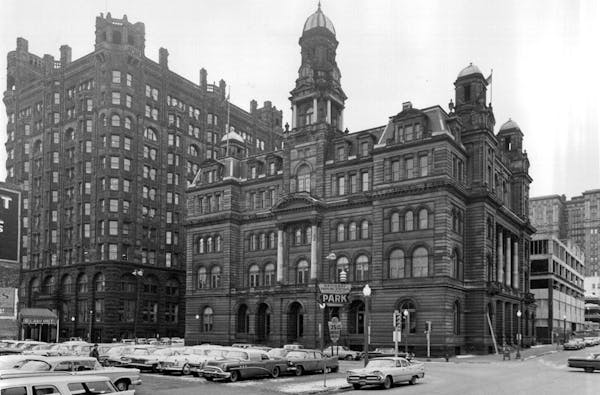Before Minneapolis was a city of skyscrapers, steeples dominated its skyline.
In the late 19th century, the most prominent steeple of all belonged to the Church of the Redeemer at 8th Street and 2nd Avenue S.
Long one of downtown's most familiar monuments, the church was plagued by fire and storms. It was nearly lost to fire in 1888, suffered damage in the 1904 tornado that swept away part of the High Bridge in St. Paul and was finally consumed by flames in 1953, by which time it was home to St. Olaf's Catholic Church.
Fire has long been the scourge of churches, as the recent blaze at Notre Dame in Paris so dramatically demonstrated. A half-dozen or more downtown Minneapolis churches were destroyed by fire over the years, but the Church of the Redeemer may be the only one that went up in flames twice.
When it opened in 1876, the English Gothic style church was possibly the most splendid in the city, its elegant spire rising to 212 feet. A four-sided clock — an uncommon feature for a church — tolled the hours from the base of the spire.
Built of sturdy Platteville limestone quarried nearby, the church seated 1,000 worshipers and featured numerous stained-glass windows, among them one donated by flour milling tycoon William D. Washburn. The church was built by the First Universalist Society of Minneapolis, founded in 1859. By the 1870s the society's membership included Thomas Lowry, Dorilus Morrison, Washburn and other wealthy locals. They provided the wherewithal to construct the church for the then-hefty sum of $80,000.
The first big fire at the church occurred on Jan. 15, 1888, in the midst of a bitter cold snap that sent the temperature in Minneapolis plunging to 31 degrees below zero. The church's janitor was ill that night, according to newspaper accounts, and entrusted to his 14-year-old son the task of stoking the church's five coal-burning furnaces in time for Sunday morning services.
Something went wrong and a fire ignited in a basement wall behind the furnaces. The church began to fill with smoke as fire crews rushed to the scene. But the source of the fire proved elusive, and it smoldered inside the walls for hours before bursting out into the open. By the time the fire was finally brought under control, little remained of the church except its stone walls and tower.
The thick stone walls proved to be sturdy, however, and the church's gutted interior was rebuilt and slightly enlarged under the direction of the architectural firm of Long and Kees, best known today as the architects of Minneapolis City Hall. The church was rededicated in November 1889 at ceremonies that drew extensive coverage in local newspapers.
At that time about a dozen churches stood in what is now downtown's central core, including Westminster Presbyterian (then at 7th Street and Nicollet Avenue), Hennepin Avenue Methodist (at 10th Street and Hennepin Avenue), Plymouth Congregational (then at 8th Street and Nicollet) and St. Mark's Episcopal (on 6th near Nicollet). But as the commercial core relentlessly expanded in the early 1900s, almost all of these old congregations cashed in on their valuable property and built new churches in the Loring Park area or elsewhere around the downtown fringes.
By 1920 only the Church of the Redeemer, which had sustained minor damage in the 1904 tornado, remained on its historic downtown grounds. But membership began to decline, a trend that continued for the next 20 years, and in 1941 the Universalist Society sold its historic stone church for $112,500 to the Archdiocese of St. Paul and Minneapolis, which had decided to create a parish — St. Olaf's — to serve downtown workers and residents. After extensive refurbishing, the church was dedicated on June 1, 1941.
Twelve years later, fire struck again, this time after Ash Wednesday services on the night of Feb. 18, 1953. The church's assistant pastor was in the rectory about 10:15 p.m. when he "heard something fall" in the church. He went to investigate and discovered the ceiling was on fire.
According to the Minneapolis Star, "the blaze apparently started in a storage attic behind the main altar and above the rectory. It spread with stunning rapidity as burning timbers, loosened from the ceiling, fell into pews and onto carpeting."
It quickly turned into a four-alarm inferno as flames shot 100 feet into the air, sending up an eerie glow that drew an estimated 7,500 spectators from across the city. WCCO-TV, with studios just a block from the church, provided live coverage of the fire, a first for television news in the Twin Cities.
The blaze was finally extinguished, but only after causing irreparable damage. One wall of the church collapsed, as did the wood-framed roof, and the interior was destroyed. As had been the case in 1888, however, the heavy stone tower and its steeple survived. Even so, there would be no third life for the historic church. City building inspectors determined that the remaining stone walls and tower were structurally unsound and ordered immediate demolition.
Six days after the fire, workers used a crane and ropes to pull down the steeple, a spectacle that drew a crowd. Among the onlookers was legendary columnist Barbara Flanagan, then a young reporter, who wrote the story for the Tribune.
A new St. Olaf was completed on the site in 1955, its tower outfitted with nine bells salvaged from the old church. In just 13 years, the present church will have lasted as long as its predecessor, provided the demons of fire and storm can be kept at bay.
Larry Millett is an architecture critic and author of 14 nonfiction books and eight mystery novels. He can be reached at larrymillett.com.











